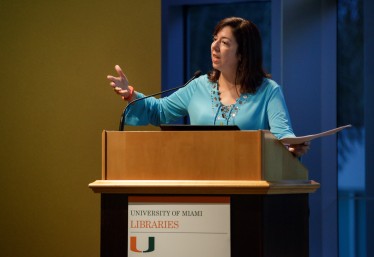By Peter E. Howard
UM News

Historian Yeidy M. Rivero credits the Cuban Heritage Collection for igniting her passion for examining commercial television in Cuba.
CORAL GABLES, Fla. (September 10, 2015) – When he came to power in Cuba in 1959, Fidel Castro wasted little time taking to the airwaves.
An imposing figure who liked the sound of his own voice, the uniform-clad revolutionary frequently promoted his political objectives on television. Sometimes his speeches went on for as long as eight hours, without a commercial break.
At the time, the television stations were privately owned, and it wasn’t until a year to 18 months later that the government took over. It knew the power of the medium back then, and used it to its advantage.
“Castro was marketing the revolution,” said Yeidy M. Rivero, author of the book Broadcasting Modernity, which examines the history of commercial television in Cuba from 1950 to 1960. “He was very charismatic, and he used it perfectly well.”
Rivero, a professor at the University of Michigan, was at the University of Miami’s Otto G. Richter Library Wednesday night to talk about her book, and engage the audience gathered in the Cuban Heritage Collection’s Roberto C. Goizueta Pavilion in a discussion about the birth of commercial television in Cuba during a period of political and economic upheaval.
It was a homecoming of sorts for the historian. Rivero credits the research she did at the Cuban Heritage Collection at UM Libraries for igniting her passion for the project. From day one, she recalled, she was provided a daily cafecito to enjoy – “with plenty of sugar.”
“I feel like this is part of my family,” Rivero shared.
Cuba’s history with television is remarkable, with the island nation at the cutting edge of production and programming from the beginning. Talented employees helped advance the products. Some fled Cuba because of the instability, enriching television production in other Latin American countries, including Venezuela and Puerto Rico.
Cuba, Rivero said, was the first country in Latin America to have color television, and second in the world to feature it after the United States.
Rivero added that she has always been “fascinated by the popularity of the medium,” and began researching commercial television in Cuba about a decade ago. She read every newspaper and magazine article she could find on television in Cuba, and was pleasantly surprised to find detailed analyses in documents at the Biblioteca Nacional José Martí Centro de Investigaciones del Instituto Cubano de Radio y Televisión in Havana.
Early television in Cuba, she said, was used to convey the country as modern, emerging, economically successful, educated, and morally sound. Some rumba dances were censored on television because they were deemed too risqué.
“When I began my research,” Rivero said, “I had no idea what I would find.”










